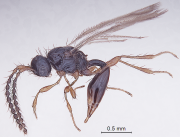 Fig 1. Female, profile |
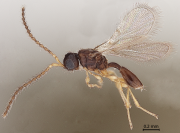 Fig 2. Male, profile |
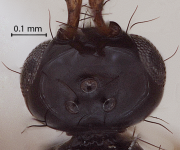 Fig 3. Head, dorsal view |
 Fig 4. Antenna (female) |
 Fig 5. Antenna (male) |
 Fig 6. Forewing |
|
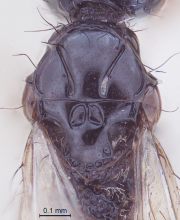 Fig 7. Mesosoma |
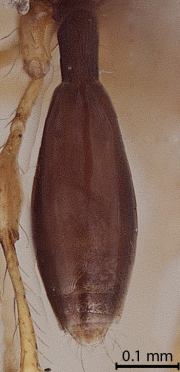 Fig 8. Metasoma (male) |
 Fig 9. Distribution map |
|
Nomenclature
Vadana Rajmohana and Narendran 2000a: 21. Type species: Vadana sholayarica Rajmohana and Narendran.
Diagnosis
About 2mm long, delicate forms. Head and body pale yellowish brown, with appendages much lighter in colour. Body smooth and shining, lacking micropilosity, but with sparse, long, semierect hairs. Post gena and petiole without foam-like structures. Hairy cushions on postgena, sides of pronotum and upper part of propleuron sparse. Antennal shelf weakly developed, toruli separated by a gap. Antennae 12-segmented in females, 14-segmented in males. Female antennae without clava, but with terminal antennal segments gradually enlarged. Male antenna elongate, filiform. Segments from A3 onwards barrel shaped and with dense pilosity. A3 subequal to A4. Scattered hairs on both male and female antennae as long as or longer than A2 length. A4 not modified in males. Eyes with very sparse (either two or three) pilosity, hairs stout and as long as those on body. Mouthparts normal, with mandibles bidentate. Occiput step-like.
Cervix distinct with longitudinal striae and subcircular reticulations. Pronotal shoulders almost rounded. Notauli diverging in front, not reaching transscutal sulcus. Humeral sulcus distinct. Anterior scutellum bifoveate. Prescutellar pits, lateral scutellar pits and posterior scutellar pits present. Sternaulus indicated. Dorsellum and propodeum with three longitudinal median keels. Propodeum richly sculptured. Median keel on propodeum superimposed with small rounded punctuate, nucha indicated.
Wings fully developed. Venation extending to nearly half of forewing length. Submarginal vein remote from costal margin of forewing. Marginal vein elongate. Postmarginal vein absent, stigmal vein well developed. Basal vein nebulous and arcuate, with one or two clear hairless streaks medially and submedially on forewing disc. Marginal cilia on forewings well-developed, nearly as long as one-third of forewing width. Hindwings with submarginal vein complete.
Petiole always longer than wide, tubular, remarkably arched in profile, usually with faint longitudinal striae. Metasoma past petiole moderately compressed laterally, narrow, not as wide as mesosoma. Anterior margin of syntergite without any furrow or emargination. Apical tergites visible only as narrow rings underneath. Metasomal tip conical and pointed in females, blunt in males.
Geographic Distribution
See Fig. 9 for Indian distribution of the genus.
Species known from India
1. Vadana sholayarica Rajmohana & Narendran
Remarks
Not common in collections. A delicate body, bent or curved petiole, normal mandibles, 12-segmented female and 14-segmented male antennae, clava non abrupt in females, distinct notauli, bifoveate scutellar pits, and forewings with well developed marginal cilia, serve to distinguish this genus from other diapriines.
References
|